
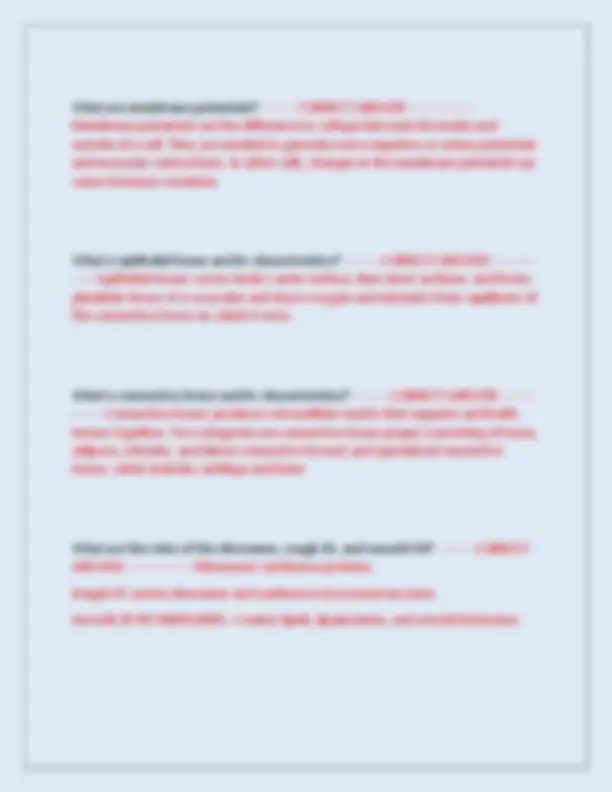
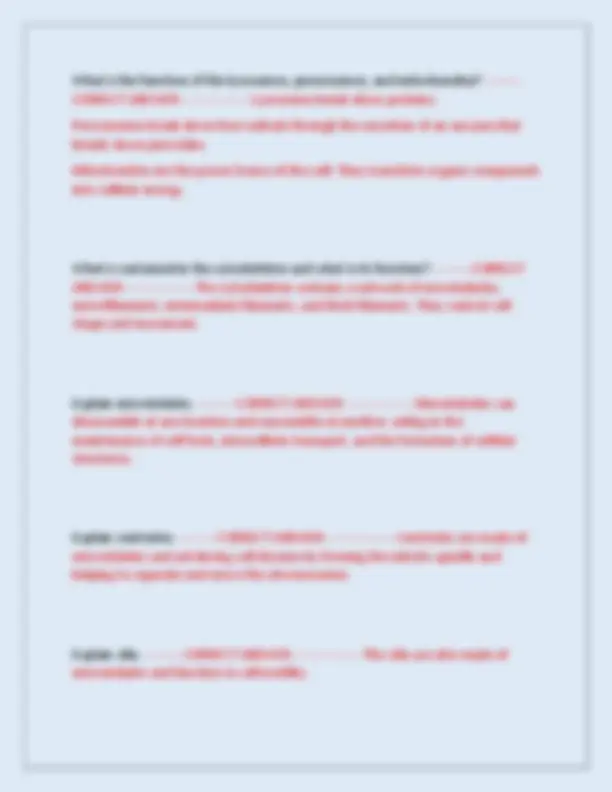
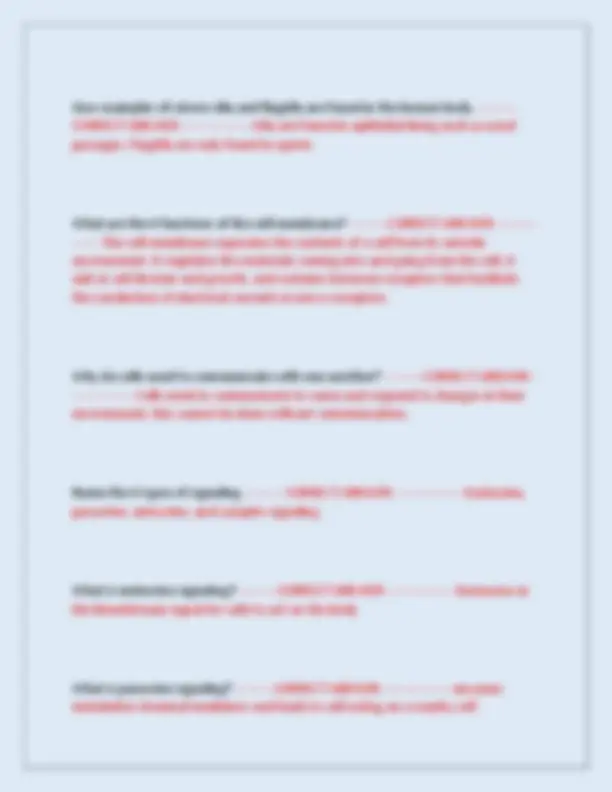
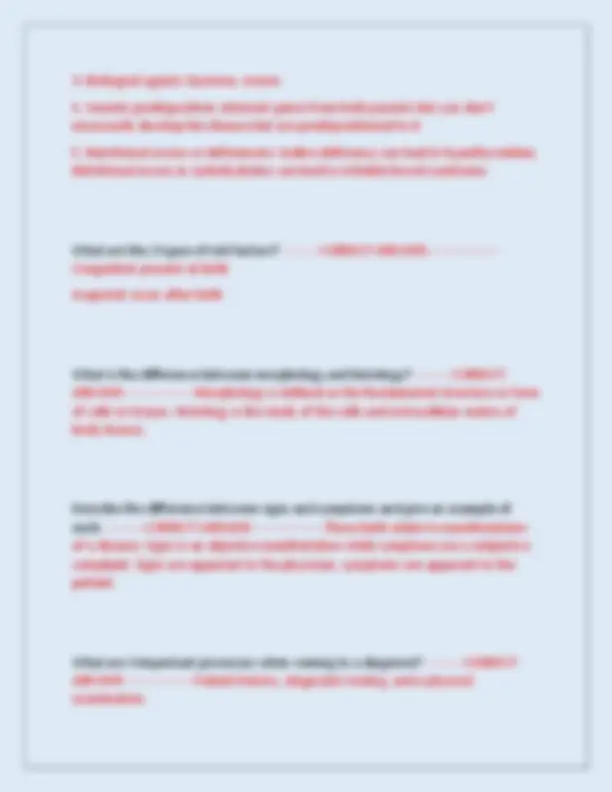
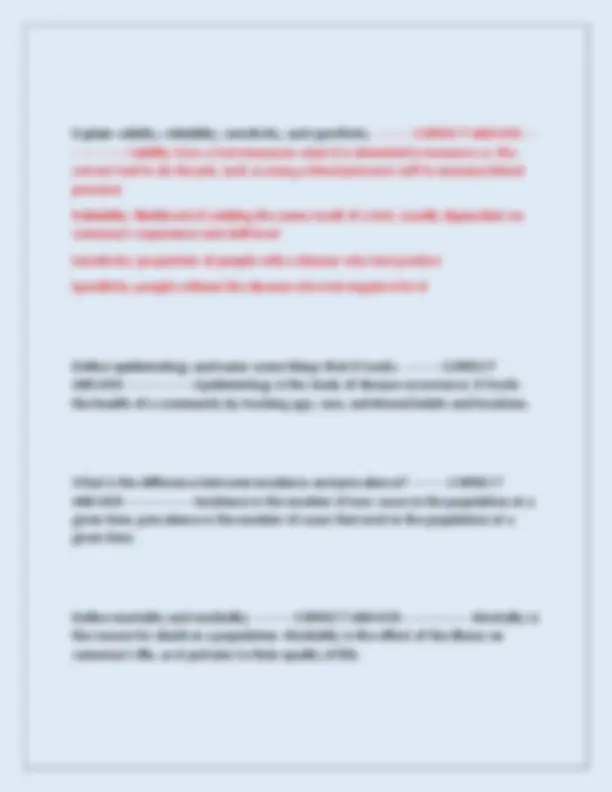
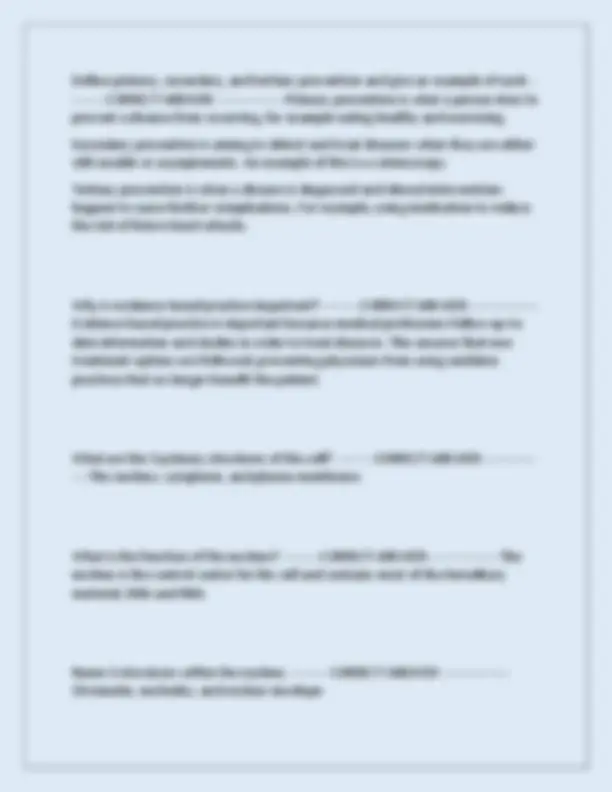
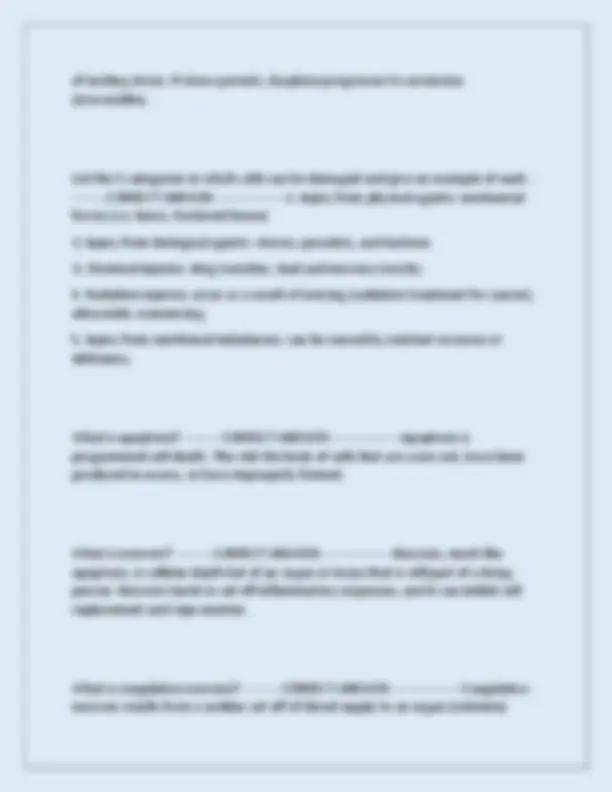
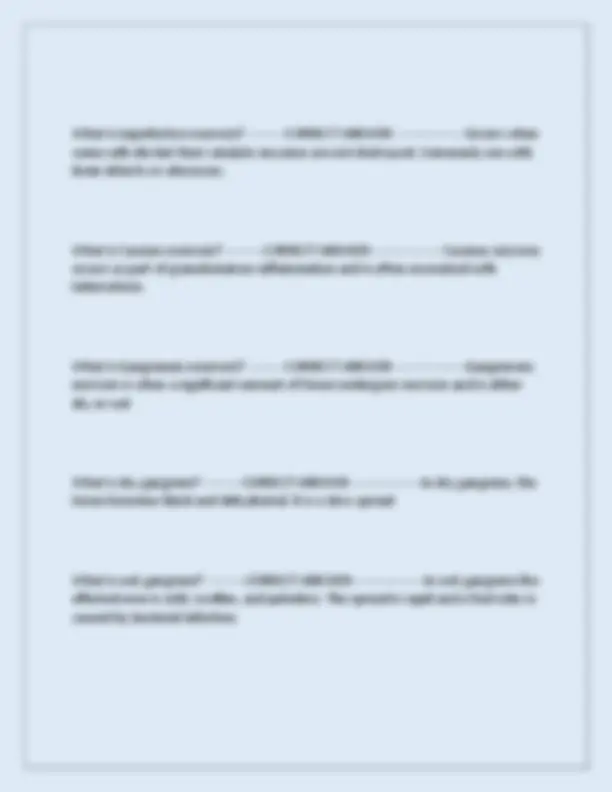
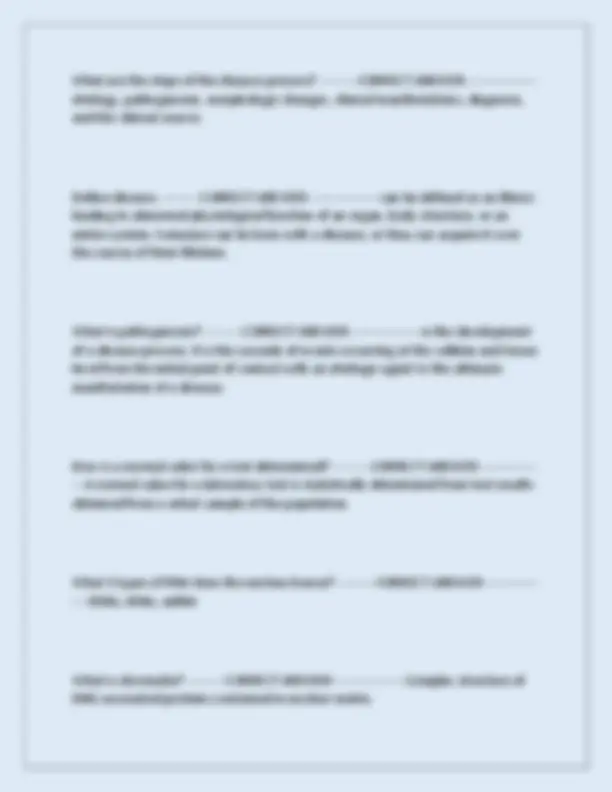
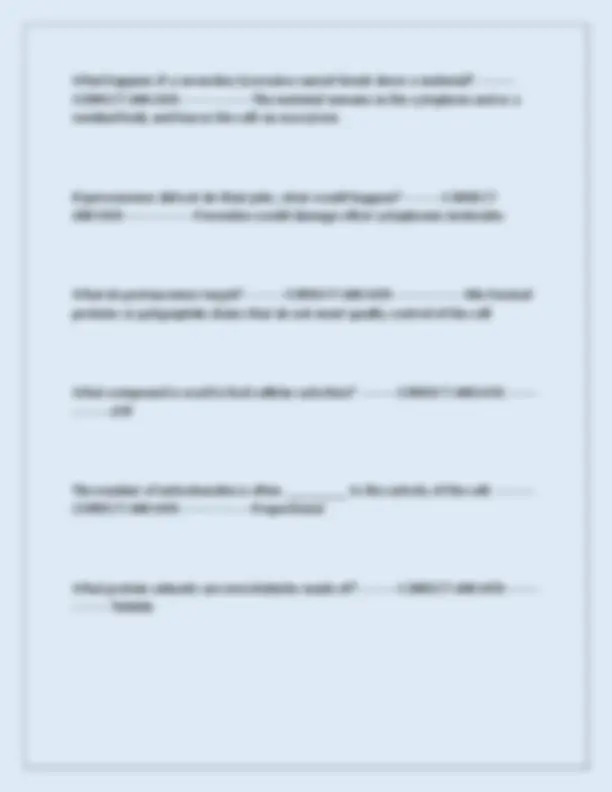
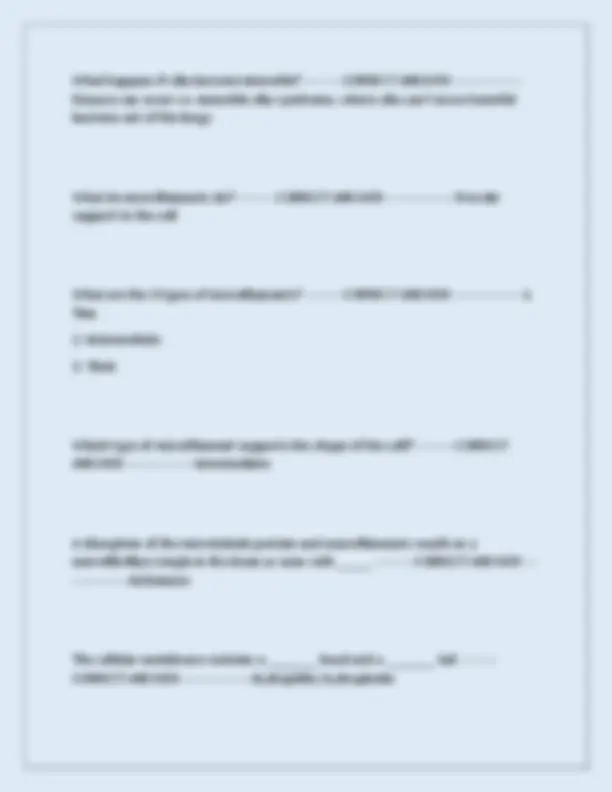
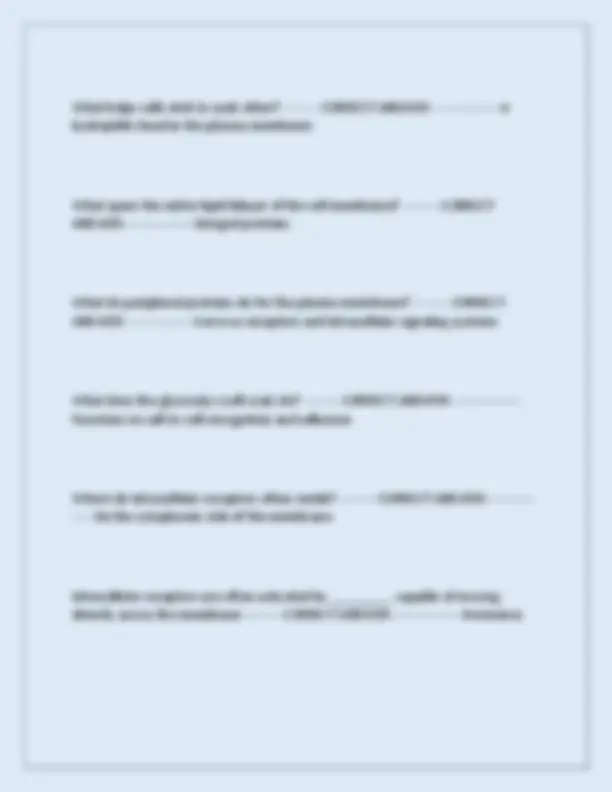


Study with the several resources on Docsity

Earn points by helping other students or get them with a premium plan


Prepare for your exams
Study with the several resources on Docsity

Earn points to download
Earn points by helping other students or get them with a premium plan
Community
Ask the community for help and clear up your study doubts
Discover the best universities in your country according to Docsity users
Free resources
Download our free guides on studying techniques, anxiety management strategies, and thesis advice from Docsity tutors
The BIOD 331 Module 1 Exam for 2025 focuses on fundamental concepts in pathophysiology, providing a comprehensive overview through a series of questions and verified correct answers. This exam is an invaluable resource for students aiming to deepen their understanding of cellular processes and disease mechanisms. Key topics include cellular processes such as endocytosis, pinocytosis, and phagocytosis. Endocytosis involves the cell engulfing external substances, while pinocytosis and phagocytosis refer to "cell drinking" and "cell eating," respectively. The exam emphasizes the importance of ion channels for crossing cell membranes, given the lipid bilayer's hydrophilic and hydrophobic properties.
Typology: Exams
1 / 20

This page cannot be seen from the preview
Don't miss anything!













Define endocytosis. ---------CORRECT ANSWER-----------------Endocytosis is the process by which a cell takes in substances from outside itself by engulfing them in a vesicle (such as nutrients or pathogens that immune cells engulf and destroy). What is pinocytosis? ---------CORRECT ANSWER-----------------Pinocytosis is "cell drinking", where the cell engulfs small solid or fluid particles such as proteins and electrolytes. What is phagocytosis? ---------CORRECT ANSWER-----------------Phagocytosis means "cell eating" where the membrane engulfs then kills microorganisms or other molecules. Once the particle is enclosed, a phagosome is formed and it moved into the cytoplasm where a lysosome meets it to be destroyed. (think: white blood cells, leukocytes) Why are ion channels necessary? ---------CORRECT ANSWER-----------------Ions are unable to cross the cell membrane due to the arrangement of hydrophilic heads and hydrophobic tails in the lipid bilayer. In order to cross the membrane, they must interact with membrane receptors.
What is primary active transport? ---------CORRECT ANSWER-----------------ATP is used directly to transport the substance What is secondary active transport? ---------CORRECT ANSWER-----------------Energy is derived from the primary active transport of one substance, usually sodium, for the cotransport of a second substance What develops when sodium leaves the cell by primary active transport? --------- CORRECT ANSWER-----------------A concentration gradient. What are the two groups of secondary active transport? ---------CORRECT ANSWER-----------------Cotransport and counter transport What is cotransport? ---------CORRECT ANSWER-----------------Cotransport or symport systems consist of sodium ions and the solute being transported in the same direction. An example of cotransport occurs in the intestine in which the absorption of glucose and amino acids is paired with sodium transport. What is counter transport? ---------CORRECT ANSWER-----------------Counter- transport or antiport systems has sodium ions and the solute being transported in the opposite direction
What is the function of the lysosomes, peroxisomes, and mitochondria? --------- CORRECT ANSWER-----------------Lysosomes break down proteins. Peroxisomes break down free radicals through the secretion of an enzyme that breaks down peroxides. Mitochondria are the power house of the cell. They transform organic compounds into cellular energy. What is contained in the cytoskeleton and what is its function? ---------CORRECT ANSWER-----------------The cytoskeleton contains a network of microtubules, microfilaments, intermediate filaments, and thick filaments. They control cell shape and movement. Explain microtubules. ---------CORRECT ANSWER-----------------Microtubules can disassemble at one location and reassemble at another, aiding in the maintenance of cell form, intracellular transport, and the formation of cellular structures. Explain centrioles. ---------CORRECT ANSWER-----------------Centrioles are made of microtubules and aid during cell division by forming the mitotic spindle and helping to separate and move the chromosomes. Explain cilia. ---------CORRECT ANSWER-----------------The cilia are also made of microtubules and function in cell motility.
Give examples of where cilia and flagella are found in the human body. --------- CORRECT ANSWER-----------------Cilia are found in epithelial lining such as nasal passages. Flagella are only found in sperm. What are the 4 functions of the cell membrane? ---------CORRECT ANSWER---------- -------The cell membrane separates the contents of a cell from its outside environment. It regulates the materials coming into and going from the cell, it aids in cell division and growth, and contains hormone receptors that facilitate the conduction of electrical currents in nerve receptors. Why do cells need to communicate with one another? ---------CORRECT ANSWER-- ---------------Cells need to communicate to sense and respond to changes in their environment, this cannot be done without communication. Name the 4 types of signaling. ---------CORRECT ANSWER-----------------Endocrine, paracrine, autocrine, and synaptic signaling What is endocrine signaling? ---------CORRECT ANSWER-----------------hormones in the bloodstream signal for cells to act on the body What is paracrine signaling? ---------CORRECT ANSWER-----------------enzymes metabolize chemical mediators and leads to cell acting on a nearby cell
What are enzyme-linked receptors? ---------CORRECT ANSWER-----------------Growth factors. Have their ligand-binding site on the outside of the cell membrane. It activates an intracellular domain with enzyme activity, linked to growth factors, and respond to increased potassium-sodium exchanges, influxes of calcium, and stimulation of glucose and amino acid uptake. What are Ion-channel-linked receptors? ---------CORRECT ANSWER----------------- Neurotransmitters. Found on nerve and muscle cells. They are highly excitable and synaptic signaling is rapid. Neurotransmitters use this type of signaling to open or close ion channels formed by integral proteins in the cell membrane. What is diffusion? ---------CORRECT ANSWER-----------------Molecules go from an area of high concentration to an area of low concentration until they are equally distributed. i.e. Electrolytes move from an area of high concentration one one side of a cell membrane to an area of lower concentration on the other side. What is the definition of "pathophysiology"? ---------CORRECT ANSWER--------------- --Pathophysiology is defined as not only the cellular and organ changes that occur with disease, but also the effects that these changes have on total body function. Name the 5 etiologic factors and give an example if listed. ---------CORRECT ANSWER-----------------Etiologic factors are the causes of a disease.
Define primary, secondary, and tertiary prevention and give an example of each. - --------CORRECT ANSWER-----------------Primary prevention is what a person does to prevent a disease from occurring, for example eating healthy and exercising. Secondary prevention is aiming to detect and treat diseases when they are either still curable or asymptomatic. An example of this is a colonoscopy Tertiary prevention is when a disease is diagnosed and clinical interventions happen to cause further complications. For example, using medication to reduce the risk of future heart attacks. Why is evidence-based practice important? ---------CORRECT ANSWER----------------- Evidence-based practice is important because medical professions follow up-to- date information and studies in order to treat diseases. This ensures that new treatment options are followed, preventing physicians from using outdates practices that no longer benefit the patient. What are the 3 primary structures of the cell? ---------CORRECT ANSWER------------- ----The nucleus, cytoplasm, and plasma membrane What is the function of the nucleus? ---------CORRECT ANSWER-----------------The nucleus is the control center for the cell and contains most of the hereditary material, DNA and RNA. Name 3 structures within the nucleus. ---------CORRECT ANSWER----------------- Chromatin, nucleolus, and nuclear envelope
What is facilitated diffusion? ---------CORRECT ANSWER-----------------uses a transport protein to help lipid insoluble or large molecules pass through the cell membrane. What is active transport? ---------CORRECT ANSWER-----------------Cells use energy to move against an electrical or chemical gradient. Example: sodium-potassium- ATPase pump. This pump moves sodium from inside the cell to the extracellular region and returns potassium to the inside of a cell. What is the most important active transport system and why is it important? ------ ---CORRECT ANSWER-----------------The sodium-potassium-ATPase pump is the most important active transport system. The removal of sodium and the replacement with potassium causes the cell to maintain its structural integrity. If sodium remained in the cell, the cell would swell and die. What is muscle tissue? ---------CORRECT ANSWER-----------------Muscle tissue: moves the skeletal structures, pumps blood through the heart. Three types: skeletal, cardiac, and smooth What is nervous tissue? ---------CORRECT ANSWER-----------------Nervous tissue: found throughout body and used for communication between peripheral tissues and central nervous system. Senses and moves about the environment. Two types of cells: glial (supporting neurons) and neurons (function in communication)
of inciting stress. If stress persists, dysplasia progresses to carcinoma (irreversible). List the 5 categories in which cells can be damaged and give an example of each. - --------CORRECT ANSWER-----------------1. Injury from physical agents: mechanical forces (i.e. burns, fractured bones)
What is Liquefactive necrosis? ---------CORRECT ANSWER-----------------Occurs when some cells die but their catalytic enzymes are not destroyed. Commonly see with brain infarcts or abscesses. What is Caseous necrosis? ---------CORRECT ANSWER-----------------Caseous necrosis occurs as part of granulomatous inflammation and is often associated with tuberculosis. What is Gangrenous necrosis? ---------CORRECT ANSWER-----------------Gangrenous necrosis is when a significant amount of tissue undergoes necrosis and is either dry or wet What is dry gangrene? ---------CORRECT ANSWER-----------------In dry gangrene, the tissue becomes black and dehydrated. It is a slow spread What is wet gangrene? ---------CORRECT ANSWER-----------------In wet gangrene the affected area is cold, swollen, and pulseless. The spread is rapid and a foul odor is caused by bacterial infection.
What does the nucleolus do? ---------CORRECT ANSWER-----------------Processes rRNA and assembl it into ribosomes. How many chromosomes are nucleoli comprised of? ---------CORRECT ANSWER---- -------------Five The nuclear envelope _____ the nucleus and contains _____ nuclear membranes. ---------CORRECT ANSWER-----------------surrounds; contains Certain materials will move in both directions through the nuclear envelope. What are they? ---------CORRECT ANSWER-----------------Fluids, electrolytes, RNA, proteins, and hormones What 5 organelles are found within the cytoplasm? ---------CORRECT ANSWER------ -----------1. Ribosomes
What does the ER do? ---------CORRECT ANSWER-----------------Functions as a transportation system for substances throughout the cell What does the Golgi apparatus do? ---------CORRECT ANSWER-----------------Takes substances produced in the ER, modifies them, and packages them into secretory granules or vesicles. Think: USPS mail sorting center Lysosomal enzymes require a ______ environment to work best ---------CORRECT ANSWER-----------------Acidic Give an example of a disease that results from inactive lysosomes ---------CORRECT ANSWER-----------------Tay-Sachs disease What is heterophagy? ---------CORRECT ANSWER-----------------Digestion of a substance phagocytosed (ingest or engulf) from outside of the cell What is autophagy? ---------CORRECT ANSWER-----------------Digestion of damaged cellular organelles which lysosomes must remove in order for the cell to function properly
What happens if cilia become immotile? ---------CORRECT ANSWER----------------- Disease can occur i.e. immotile cilia syndrome, where cilia can't move harmful bacteria out of the lungs What do microfilaments do? ---------CORRECT ANSWER-----------------Provide support to the cell What are the 3 types of microfilaments? ---------CORRECT ANSWER-----------------1. Thin
What helps cells stick to each other? ---------CORRECT ANSWER-----------------A hydrophilic head in the plasma membrane What spans the entire lipid bilayer of the cell membrane? ---------CORRECT ANSWER-----------------Integral proteins What do peripheral proteins do for the plasma membrane? ---------CORRECT ANSWER-----------------Serve as receptors and intracellular signaling systems What does the glycocalyx (cell coat) do? ---------CORRECT ANSWER----------------- Functions in cell-to-cell recognition and adhesion Where do intracellular receptors often reside? ---------CORRECT ANSWER------------ -----On the cytoplasmic side of the membrane Intracellular receptors are often activated by _________ capable of moving directly across the membrane ---------CORRECT ANSWER-----------------Hormones